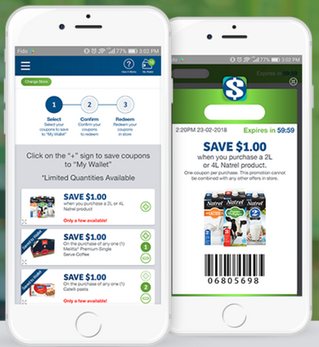Loyalty programs in Canada 2022 overview: paper coupons vs reward application. What's next?
- Julia Rovers

- Mar 17, 2022
- 6 min read
Updated: Jun 29, 2022

In this Article:
1. Introduction
6. Learn, understand, act. How to build trusted Campaign Management with the low-code digital platform?
7. Bottomline
Canadians love coupons. A monthly bill on groceries can hit $250, which is $1000 for a family of four. So shoppers simply want to save money. Or… Don't they? The recent research from BrandSpark International and Metroland Media says it's not that simple.
21% of all flyer and coupon users are “Inspired” shoppers who often look through flyers for new products, ideas and information and often read flyers for sheer enjoyment.
This gives businesses an opportunity to introduce new product lines and encourage customers to try a new, more profitable brand or service.
“Engaged” shoppers were more frequent shoppers than any other psychographic segment in the categories studied.
Do you target to meet the needs of the “Deal-Seeking” shopper? There is a real opportunity for brands and retailers to integrate more inspirational content into their flyers to serve and appeal to the attractive “Engaged” and “Inspired segments.

Okay, we know now who and why uses these options. But today, coupons and free offers are different from the ones our parents used to clip when the Sunday newspaper arrived. Big and small companies use technologies to get the most from each "great deal.” Coupons cost businesses money and may lead to lower profits for that seals. No surprise that to create and launch each campaign, companies create bright designs to attract and catch customers, and use targeting and time limits to spend their money in the best way.
From paper to… paper again.
Let's take a closer look at the types of coupons by their owner (or creator) and level of digitization.
1. Local stores with their own coupons.
The oldest and most popular is, of course, paper coupons from the shop on the corner. You used to them and just habitual check any coupon available. But the shop grues up (at least I hope it did), and now to form a set of coupons they use, for example, geo-targeting mentioned above. They also count on the New Movers – people new to an area, who must form new business relationships. Here's how local stores deliver coupons to their customers:
a. Paper coupons – in the Store, mail, office, etc. General offers, filter by categories, no personalization.
b. Digital coupons – websites or applications with all offers of the Store on your phone. Filters, categories, personalization, shopping history.
c. Online Digital coupons are websites with available offers, filters, categories, departments. After logging in – personalization of the proposals.

2. Websites-aggregators of coupons.
They, as a platform, kind of collect and organize all the best deals from the stores around. You, as a customer, receive a more or less personalized offer directly to your phone or email. You can choose a store department, type of products, specific store and get all deals available at the moment, and plan your shopping. In most cases, the websites have applications, too. But not always. Definitely not always.

3. Applications-aggregators.
The same as 2. Website-aggregators of coupons, but with a mobile application. I mention them here as a separate category because not all websites have their applications. Many website aggregators are very old-fashioned and have a poor design — still working, though. These guys have categorization, location and personalization options. They can track your shopping history (after login, of course) and create offers more accurate.
The coupons evolution
Without any doubt, coupons save money and increase interest for buying to customers. It helps to recruit new clients and re-activate former ones to the sellers. But still – let's get back to the current century, what digital solutions are there on the coupons market?
4. Software solutions created by the third party.
The App offers to stores/businesses which can’t afford their own application connecting to the service and create their offer to the customers on the platform. Pros: a business appears at the direct customer sight. Cons: a business appears at the direct customer sight among many other businesses. Nevertheless, the solution gives business one more place to be found, and to the customer:
a. List of all offers
b. Personalization
c. Shopping history
d. Direct notification
e. Customer Recognition (by phone number)
You may also like: Loyalty Management Software With A Low-Code PlatformIn some cases, the App has minor or no customization at all. But who cares, Canadians are strong and focused, they can handle if (actually, they don't).
To mention a few examples:
- WEB SAVER - offer Printable Coupons, Digital Coupons, Weekly Flyers. Something in between of paper coupons and digital offers.
- FIVESTARS - it's a handy tool for business owners. The service offers Payments, Loyalty and Retention, Marketing Automation, Promotions, Love Local Network - more than enough to start a journey of building brand awareness and loyalty. A minor drawback is that the clients can receive multiple offers from similar companies in their application. The business should act proactively to stand out.
- CADDLE - the platform works both for clients and business owners. For companies they offer to learn consumer insights by diving into Shopper/Trade Marketing, Consumer Insights, Brand Marketing, Category Development, eCommerce & Digital. For clients they offer survey and cashback opportunities powered by the brands and retailers everyone knows and loves. Smart solutions!
Coupons on the National scale
5. Cashback & Rewards applications.
Major players on a national scale. Offer coupons, flyers, cashback. They issue credit cards to get cashback and collect points to spend them inside the connected stores/services. Four big companies here:
- PC Optimum - The PC Optimum program tailors customers' rewards to match the food and products they buy most. Good news for clients: they can choose a shop with the most actual offers and best prices.

- Canadian Tire Triangle Rewards - they offer to collect Canadian Tire Money at the selected stores of the Tire, Gas+, and Essence+ with a few retailers as Partners. A new level to collect cashback with the Triangle Credit Card.
- Air Miles- "Before you buy online, sign in and browse hundreds of online stores, including top Canadian and global brands," said on the main page of their website. Collect points, change them on miles, receive cashback, pay with a special credit card. Travels included!
- Aeroplan- another service offers to collect points and change them to flying miles."We've built the new Aeroplan around the way people actually travel," said on the main page of the website. The offers list contains (but is not limited by) flights, hotel stays, car rentals, activities, brand-name merchandise and gift cards.
How can businesses use coupons to grow?
That's an excellent question, and there's no correct answer to that. In a classic meaning, coupons make customers choose the place to go shopping and to get the best deals. With the technology improvement coupons became a way of communication with the client. It is the mutual conversation now: customers show what they need by their actions or feedbacks, businesses create those 'great deals' we mentioned before to attract more customers and to satisfy their needs.
Technologies help here by analyzing customers’ behavior and creating prognoses, which work much better than a wild guess of the Marketing department (nothing personal, it's just a fact). In what way will businesses communicate to their customers - here's the trick.
The other thing that emphasizes The Coupon Bureau is minimizing fraud with digital coupons. The organization was created to set up a universal system of coupons verification connected to POS and working in a realtime. FOBI, one of the Bureau partners who helps companies implement the system, predicts coupons verification can save ~20,000+ annually per location. Sounds like a big deal, hah?
Learn, understand, act. How to build trusted Campaign Management with the low-code digital platform?
We at the XME.digital work on the edge of business and technology. So yes, we do prefer using a variety of solutions to build strong relationships with the customers. Even if it's only the coupons. Or isn't it?
What coupons can't do at all is a real-time transformation or, let's say, embedding into current business processes. Sounds like magic? No, it's science. And collecting data. A lot of data.
Here's how it works: you collect data, analyze it, understand customers' behavior, learn patterns and pack all of it inside a personalized offer for every single customer. Low-code platforms help create segmentations so detailed that this is not even micro-, it's nano-segmentation. Customers see just a coupon like they used to. But they feel tonnes of personal touch, which creates trust and leads to a better shopping experience. Which leads to loyalty. And that is our true purpose, isn't it?
Yo may also like: Real-Time Campaign Management: Personalized Shopping ExperienceBottomline
The old-fashioned coupons are plain and can't offer any personalization. Except, maybe, a geotargeting: you are more likely to live or hang out anywhere around the place you've received a paper coupon. Meanwhile, modern solutions handle a variety of different personalized data. They can consider customers' behavior and set up not even a microtargeting but nano targeting. They support building brand loyalty. They help to offer what's essential to a particular person: a discount to the one, a 'two-for-one' option to the other. Don't ignore using such powerful tools when creating your dream business. Be aware of your customer's preferences and offer them the best you have - isn't it the main reason we all do what we do?



































Comments